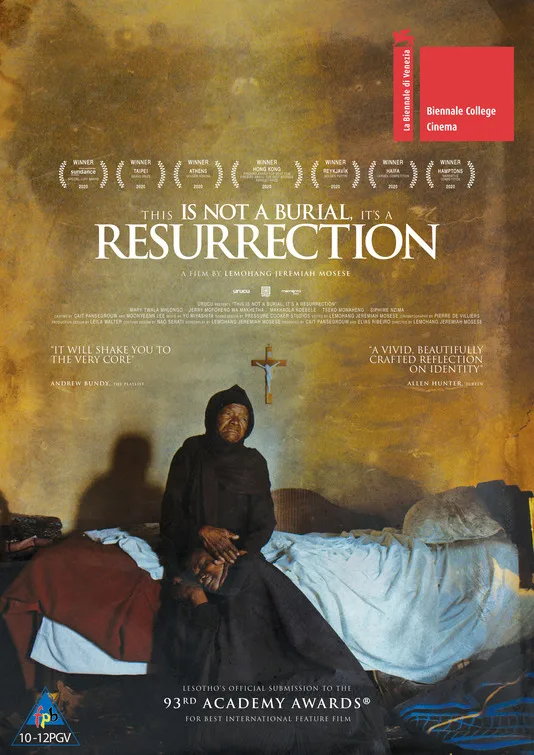A flood of false progress threatens to erase an entire village in the transcendental drama “This Is Not a Burial, It’s a Resurrection.” Such impending destruction unleashes a widow’s righteous fury on all those plotting to uproot her from the land where she wants to die and be laid to rest. Left with nothing but contempt for God, the misleadingly feeble figure won’t surrender her end-of-life dignity.
“This Is Not a Burial, It’s a Resurrection” is a searing epitaph for Mary Twala, a veteran performer at the peak of her absorbing presence. And it is a radical international breakthrough for Lemohang Jeremiah Mosese, a filmmaker who uses potential philosophical expressions to ask tough questions about the ravaged history of Africa. Set in Lesotho, an independent kingdom landlocked within the South African territory, the film grapples with the ghosts of centuries-old colonialism that are manifested today in the dismissal of native ownership. “This Is Not a Burial” is the second Southern Sotho-language feature from director Mosese, and it made history as the country’s first-ever Oscar entry for Best International Feature Film.
To narrate this saga of thunderous proportions, Mosese anachronistically introduces an ancient storyteller (Jerry Mofokeng) who plays the lesiba—a stringed-wind instrument. Rather than placing him in the vastness of a rural landscape, he speaks to us from within the confines of a decaying urban setting in the near future. The endangered town, where the government flooded in order to build a dam, is Nasaretha. Though named by the European missionaries who settled there in the 19th century, for the locals it remains known as The Plains of Weeping.
Yet instead of dwelling on the upcoming defeat, the focus of his tale is the elderly woman who raised her fist up to sky in anger and fought back with stringent defiance. That despondent heroine, Mantoa, comes to the screen in the body of the magnificent late South African actress Mary Twala, who passed away last year after the film’s festival premiere. Most recently seen in Beyoncé’s “Black Is King,” Twala, in a nearly silent part, exudes resolve fueled by the sorrow of having lost everyone.
She first goes the legal route and then into grassroots form, as all of her few-but-piercing words aim to instill in those around her the same disgust she feels at the thought of her ancestors’ graves being awash. Through the taleteller, Mosese makes clear she abandoned all trust in a higher power when her son died. Her outspoken rejection of having to leave her homeland to make way for modernity eventually infects others. Even the authority figures, the chief and the priest, question their allegiances.
The director suffuses the piece with an entrancing mysticism, accompanied by a spectral score by Yu Miyashita. Its sharp dissonance resonates as if it were a choir of voices screaming from the afterlife. As Mantoa, Twala is framed small in the wide shots that compose a large percentage of director of photography Pierre de Villiers’ boxy frames. Within each shot, the camera and the labored composition interact (by way of zooms or subtle pans) to maximize their meaning. Saturated colors, the kind so rarely seen in Western cinema these days, pan the mountainous vistas and their open sky with a gorgeous timelessness.
In featuring cultural practices and ceremonies, Mosese doesn’t entertain ethnographic curiosity but presents them as vivid part of the tapestry of the world at hand. This tacit approach to specificity that doesn’t consider the white gaze as part of its cinematic language mirrors that of recent African releases that powerfully navigate storytelling and myth, like the Ivorian “Night of the Kings” and the Sudanese “You Will Die at Twenty,” or Pedro Costa’s recent Cape Verdean-centered “Vitalina Varela” in its treatment of grief and the human reproach of the divine. All of these stories are engrossed by a stark otherworldliness.
In her pursuit of a proper sendoff out of this mortal realm that no longer seems to have room for her, Mantoa does the opposite of getting closer to the Christian deity in her final days. She decolonizes death from the spirituality imposed on her, and in which she no longer finds meaning. It’s radical to hear her denounce how all the pain she endured over her existence was perhaps for nothing.
But just as nihilism appears to reign, Mosese turns her revelations into something much more powerful than simply giving up. Her meaning is found in the soil where she stands, where her husband built her a house with his own hands so they could make a home. It’s in the memory of the remains underground and in every flower that grows above them. The extraordinary Twala makes us believe; her unwavering conviction becomes an affixed fact in a place where nothing seems immovable any longer.
Her sacrifices, as Mosese projects them in both reality and magical realism, symbolize a rebirth of a people’s self-love and respect for their past, before it was tainted by the values and concerns of outsiders. It means a rekindling of a flame to salvage what makes them authentically themselves even if far away from their physical homeland.
Though on-screen there’s never closer interaction with the adversaries, we know who they are: the forces of neo-colonialism embodied in their fellow countrymen upholding the idea of development. To confront them, Mantoa buries any fear or respect for those institutions that for so long have devalued them (the church, the state), because only that way can their pride resurrect. This horror that her people are going through is not an end, but a new beginning. They have opened their eyes through hers.
Now playing in virtual cinemas.




















